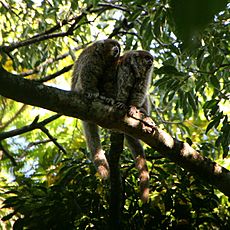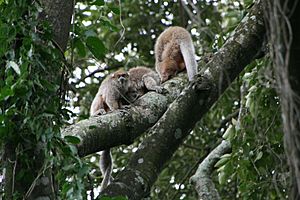White-eared titi monkey facts for kids
Quick facts for kids White-eared titi |
|
|---|---|
 |
|
| Conservation status | |
| Scientific classification | |
| Genus: |
Plecturocebus
|
| Species: |
donacophilus
|
 |
|
| White-eared titi range | |
| Synonyms | |
|
Callicebus donacophilus d'Orbigny, 1836 |
|
The white-eared titi monkey (Plecturocebus donacophilus) is also known as the Bolivian titi. This small monkey is a type of titi monkey, which are New World monkeys. You can find them in eastern Bolivia and a part of western Brazil. Their home stretches from the Manique River in Bolivia to southern Rondônia in Brazil. They also live in forests near the city of Santa Cruz de la Sierra.
White-eared titis are medium-sized monkeys. They have a grey back and an orange belly. A special feature is their white ear tufts. They eat many different things, like fruits, plants, and insects. Big birds like raptors often hunt them. Other animals like cats and even other monkeys might also attack them.
These monkeys are monogamous, meaning they usually mate for life. They live in small family groups of two to seven members. These groups include the adult pair and their young. Each family has a special area they call their home range, which is about 0.5 to 14 acres. Adult titis use many different calls to protect their territory. They are also famous for wrapping their tails together when they sit close. White-eared titis can live for over 25 years when cared for by humans.
The number of white-eared titis is going down. This is mainly because humans are destroying their homes. Even so, the International Union for Conservation of Nature (IUCN) said in 2008 that they are of "least concern." This means they are not in immediate danger. They can adapt to changes in their habitat and live in many different places.
Contents
About the White-eared Titi
The white-eared titi is part of the Pitheciidae family of New World monkeys. This family also includes saki monkeys, bearded sakis, and uakaris. The white-eared titi was first named Callicebus donacophilus in 1836. Later, scientists used new information to place it in a different group called Plecturocebus.
Within the Plecturocebus group, the white-eared titi is related to several other titi monkeys. These include the Rio Beni titi, Rio Mayo titi, Olalla brothers' titi, white-coated titi, and Urubamba brown titi. Sometimes, the white-coated titi was thought to be a type of white-eared titi. But now, they are seen as separate species.
What White-eared Titis Look Like
The white-eared titi is a medium-sized primate. Its fur can be grey or orange. Males and females look very similar in size. Males are about 311 mm long, and females are about 340 mm long. Their fluffy tail is longer than their head and body combined.
They have thick fur. Their back and limbs can be grey or orange, with an orange belly. They have special white tufts of fur on their ears. These monkeys usually weigh between 800 and 1200 grams. Females are often a bit lighter. They have 36 teeth in total. Their canine teeth are shorter than those of some other New World monkeys. In zoos, white-eared titis can live for more than 25 years.
White-eared Titi Behavior
White-eared titis are active during the day. They are also cryptic, meaning they are good at hiding. They live in small family groups. They are a monogamous species, which means a male and female usually stay together for life. Their groups typically have two to seven members: the adult pair and their young. Sometimes, groups with more than one male have been seen.
The male titi monkey carries the babies. The young stay with the male unless they are feeding. When they are two to four years old, the young monkeys leave their family group. Females tend to leave earlier than males.
The adult male and female in a pair have a very strong bond. They stay close and do things together. One monkey might follow the other, and who leads can change during the day. They show their strong bond by grooming each other, cuddling with their tails wrapped together, and gently touching. Titi monkeys are very protective of their territory. If another family group comes near, both groups will act threatening. Males will get more upset with other males who intrude. If a pair is separated, they show a lot of stress.
Communication and Calls
Titi monkeys are known for their many different calls. They have a complex way of talking to each other. Their calls can be either high-pitched and quiet, or low-pitched and loud. They often combine calls to make long sequences. These calls are used to show distress, conflict, play, or to strengthen their family bond. They also use calls to warn others about danger or to mark their territory.
The high-pitched quiet calls are mostly used when the monkeys are disturbed. They might also use them before or after group calls, when looking for food, or to find other group members. The loud, low-pitched calls are used for long-distance communication between groups. These calls help keep different family groups spaced out. The male and female often call together in what is called a "duet." If a nearby group hears these calls, they will answer with their own duetting.
Movement and Habitat
The white-eared titi lives mostly in trees. This is called being arboreal. They spend most of their time in the lower parts of the forest. They might go higher into the main tree canopy when they need to travel longer distances. They rarely cross open ground. When they move, they usually walk, climb, and leap on all four limbs. They can also bound and climb. They make small leaps between trees, usually no more than a few body lengths. This happens when the plants are not thick enough to support their usual way of moving. When on the ground, they leap more than 1 meter. Titi monkeys prefer branches that are less than 5 cm wide. Their tail never touches the branch they are on.
White-eared Titi Ecology
Not much is known about the daily life of white-eared titis. They are active from sunrise to sunset. How much food is available can change their activity times. If there is a lot of fruit in warmer months, they might start earlier. If food is scarce, they might stay at a feeding tree longer into the evening. Titi monkeys usually rest in the middle of the day. They have two main times for eating: in the morning and in the afternoon. They eat more towards the end of the day. On average, they are active for 11.5 hours, and spend about 2.7 hours eating. Titi monkeys sleep on branches at least 15 meters above the ground. Like when they rest during the day, they huddle together and wrap their tails to sleep.
White-eared titis are omnivores, meaning they eat both plants and animals. They eat fruits, leaves, insects, and seeds. They eat a lot of leaves, especially young, protein-rich leaves and leaf buds. Because leaves are hard to digest, they spend a lot of time resting to break down the cellulose. They eat from over 100 different kinds of plants and fruits. Titi monkeys also eat small insects like ants, moths, butterflies, and spiders. They can even catch flying insects if they come close. During the dry season, they eat more leaves because there is less fruit. When mothers are feeding their babies, they might eat more insects to get extra protein.
A titi monkey might travel between 425 and 1152 meters in a day. Their home range can be between 0.005 and 0.14 square kilometers. During the dry season, there is less fruit, so they don't need to travel as far. Their daily travel distance might be only a third of the usual. Their home range is often shared with other monkey species. These include marmosets, squirrel monkeys, capuchins, owl monkeys, howler monkeys, and spider monkeys. Titis sometimes get chased away from food by bigger monkeys. They generally try to avoid other primates.
Habitat and Where They Live
The white-eared titi lives in tropical forests. They prefer drier areas over very wet ones. You can find them near rivers and in gallery forests, which are forests along rivers. They are also found in open areas like grasslands and swampy grasslands. They like places with thick plants and often choose the densest parts of the forest. This species seems to handle changes to their home quite well.
In Bolivia, white-eared titis live near the Mamoré, Grande, and San Miguel rivers. They are found east of the Manique River in Beni and in the forests around the city of Santa Cruz de la Sierra. Their range goes north into southern Rondônia in Brazil.
Protecting White-eared Titis
The white-eared titi is listed as of least concern on the International Union for Conservation of Nature (IUCN) Red List. This means they are not considered threatened. They can adapt well and are found in many places. Even though their numbers are going down, the decline is not fast enough to put them in a threatened group. This species is also listed on CITES Appendix II, which helps control their trade.
The biggest danger to white-eared titis is deforestation and habitat loss. This happens because of farming. The area around Santa Cruz de la Sierra has lost a lot of forest. But these monkeys can still live within the city and near farms. They have few natural enemies and can adapt to changes in their home. Sometimes, farms can even help them. Farmers might stop hunters from coming onto their land, which accidentally protects the monkeys. Titi monkeys can also cross open ground between forest patches. Some groups even do well in disturbed areas near people.
However, broken-up habitats can make it hard for new families to find homes. This can also reduce their chances to have babies. Scientists have suggested creating "forest corridors" to connect these broken forest areas. This would help the titi monkeys survive. White-eared titis are found in the Beni Biological Station Biosphere Reserve and the Amboro National Park in Bolivia. These protected areas help keep them safe.
See also
 In Spanish: Tití de orejas blancas para niños
In Spanish: Tití de orejas blancas para niños





